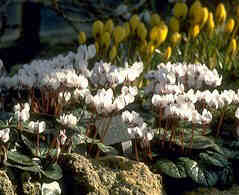Landscaping Ideas & Gardening Tips
Lawn Care Equipment & Gardening Products
|
Landscaping Home >> Landscaping Articles >> Rock Gardens
Rock Gardens If your property has a slope dotted with interesting or weathered rock formations, you have an ideal spot for a rock garden. If nature hasn't provided you with the ideal location, all you need is a few loads of topsoil and some rocks. If you must bring in your own rocks and soil, start small. The job may be bigger than you think.
If your property has a slope dotted with interesting or weathered rock formations, you have an ideal spot for a rock garden. If nature hasn't provided you with the ideal location, all you need is a few loads of topsoil and some rocks. If you must bring in your own rocks and soil, start small. The job may be bigger than you think.
RocksRocks native to your area will look natural and will be the cheapest and easiest to obtain. Large rocks with irregular shapes look interesting in the rock garden, but keep in mind that you'll need smaller rocks, too. Limestone is a good selection. The rock is soft and porous, allowing moisture to seep through, and some determined roots will be able to make their way through the rock. Limestone usually has depressions in it that can be filled with dirt for planting mosses and lichens.
PlantsThere is an endless variety of plants to choose from. Low growing perennials are the best, but since many of those best suited to rock gardens bloom only in the spring, consider strategic placement of summer-blooming heaths, heathers, herbs and annuals to add color during the rest of the season.Some purists feel that a rock garden should contain only those plants which grow naturally on rocky slopes in poor soil. Most rock gardens, however, are not located in cool climates with long winters where these plants do well. When selecting your plants, make sure they are right for your climate and exposure.
Seeds for the Rock Garden
Rock Garden Care Think of your rock garden as a collection of potted plants, and tend them accordingly. Loosen the soil in each area occasionally with a small garden fork. Most rock plants do well in poor soil, but the occasional addition of manure or compost will give them a boost.
Think of your rock garden as a collection of potted plants, and tend them accordingly. Loosen the soil in each area occasionally with a small garden fork. Most rock plants do well in poor soil, but the occasional addition of manure or compost will give them a boost.Routine care will include cutting back any leggy plants after flowering, clipping off dead stems and foliage, and dividing any plants that become root-bound or too large for its space. Check for insects and diseases regularly. Slugs may be especially pesky because they enjoy the shelter found among the rocks. Never let weeds grow in the nooks and crannies. They will easily crowd out plants in small areas. Because plants in a rock garden are more exposed than plants in a level bed, they may need more protection in winter. A heavy mulch should be applied before the first freeze in cold climates.
About the Author:
|
Attention all gardeners and landscaping professionals...
Click here to see how you can greatly increase your business, visibility, and advertising ROI...
| |